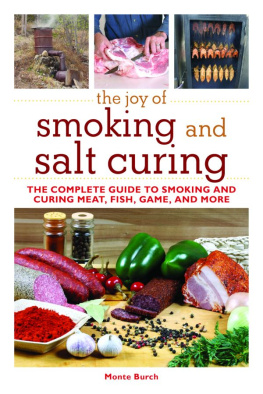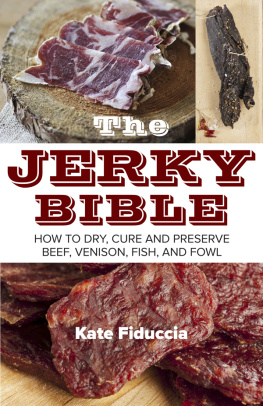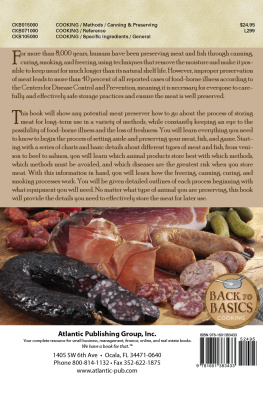A GUIDE TO CANNING, FREEZING, CURING & SMOKING MEAT, FISH & GAME
A GUIDE TO
CANNING, FREEZING, CURING & SMOKING MEAT, FISH & GAME
Wilbur F. Eastman Jr.

The mission of Storey Publishing is to serve our customers by publishing practical information that encourages personal independence in harmony with the environment.
Edited by Dianne M. Cutillo
Cover design by Cindy McFarland
Cover illustration by Scott Baldwin
Illustrations by Elayne Sears except for pages , by Doug Merrilees
Text design by Susan Bernier and Kelley Nesbit
Text production by Kelley Nesbit
Recipe credits appear on
Indexed by Thistle Index
Copyright 1975, 1989, 2002 by Storey Publishing, LLC
All rights reserved. No part of this book may be reproduced without written permission from the publisher, except by a reviewer who may quote brief passages or reproduce illustrations in a review with appropriate credits; nor may any part of this book be reproduced, stored in a retrieval system, or transmitted in any form or by any means electronic, mechanical, photocopying, recording, or other without written permission from the publisher.
The information in this book is true and complete to the best of our knowledge. All recommendations are made without guarantee on the part of the author or Storey Publishing. The author and publisher disclaim any liability in connection with the use of this information. For additional information, please contact Storey Books, 210 MASS MoCA Way, North Adams, MA 01247.
Note: Many of the food preservation procedures described in this book are subject to U.S. Department of Agriculture guidelines. Storey updates information upon publication of each edition and encourages readers to check for the most current standards by writing to Cooperative State Research, Education and Extension Service, U.S. Department of Agriculture, Washington, D.C. 20250-0900; calling 202-720-3029; or visiting the agencys Internet site at http://www/reeusda.gov/ . You may also contact the Extension Service in your county. In Canada, contact Public Information Request Service, Agriculture and Agri-Food Canada, Sir John Carling Building, 930 Carling Avenue, Ottawa, Ontario K1A 0C5; 613-759-1000; or visit the agencys Internet site at: http://www.agr.gc.ca/aafc_e.phtml .
Storey books are available for special premium and promotional uses and for customized editions. For further information, please call Storeys Custom Publishing Department at 800-793-9396.
A Guide to Canning, Freezing, Curing & Smoking Meat, Fish & Game was first published in 1975 as The Canning, Freezing, Curing & Smoking of Meat, Fish & Game and was revised in 1989. All of the information in the previous editions has been revised and updated. This edition includes new text and 16 new recipes.
Printed in the United States by Versa Press
10 9 8 7 6 5 4 3 2 1
Library of Congress Cataloging-in-Publication Data
Eastman, Wilbur F.
A guide to canning, freezing, curing & smoking meat, fish, & game/Wilbur F. Eastman, Jr.
p. cm.
Originally published: Charlotte, Vt.: Garden Way Pub. Co., 1975 under title: The canning, freezing, curing & smoking of meat, fish, & game
Includes bibliographic references and index.
ISBN 1-58017-457-4 (alk. paper)
1. Meat-Preservation. 2 Fish as food. I. Title: Canning, freezing, curing & smoking meat, fish, & game. II. Eastman, Wilbur F. Canning, freezing, curing & smoking of meat, fish, & game. III. Title.
TX612.M4 E3 2002
641.49--dc21
2002066983
The publisher wishes to thank Karen Schneider, M.E.Ed., CFCS,
and M. Dale Steen, M.A.T., CFCS, of the University of Vermont Extension,
for updating and revising this book in 2002. The 1989 edition
was revised by Lavon L. Bartel, Ph.D., R.D., then of
the University of Vermont Extension.
INTRODUCTION
This book has been designed to provide basic information to help people safely process meat, fish, and game at home.
By processing, I mean the procedures for canning, freezing, curing, and smoking; in other words, storing meat for future use.
Even if you should decide not to do your own processing, the book can still provide you with an understanding of what has happened to the meat products you see in the markets and that you may ultimately purchase for household needs.
It is intended that you find a certain amount of repetition in the book, concerning not only preparation and processing but also concerning the precautions you must take to perform these procedures safely. Since this is basically a do-it-yourself reference book, you are not expected to read the entire book each time you want directions; instead, refer to the process you intend to use or to the type of meat you wish to process. To save you time and to make the book as efficient and practical a tool as possible, some amount of repetition and referral seemed not only reasonable but also important.
No book of this sort can presume to be complete. Therefore, you are frequently referred to the instructions the manufacturer supplies with processing equipment, and alerted to the fact that new materials and equipment are constantly coming onto the market.
The recipe sections throughout contain selected recipes that should show that processing is simple and may be made personal; it is by no means meant to be a complete roundup of processed meats but is meant to encourage you to strike out on your own provided you do not disregard the customary precautions that have been discussed.
When researching material for a book, the author frequently encounters a variety of methods and directions in connection with various facets of the subject under investigation. Sometimes these methods and directions are at considerable variance with one another. The subject of processing meat is no exception to this experience.
For instance, there are honest debates concerning the value of saltpeter (potassium nitrates/nitrites) for curing meat. Some insist that saltpeter controls botulism; potassium nitrate has antioxidant and bacteriostatic properties that help retard spoilage and bacterial growth. Others maintain saltpeters main purpose is to give meat a bright color, though it also adds flavor; still others maintain that it is an additive that could possibly be harmful to the body if ingested in large quantities, that meat can just as easily be cured without it, and that there are other ways to protect against botulism.
Another area of sharp differences is home processing versus commercial processing. Certainly, commercial plants, especially those under rigid federal control and inspection, are required to butcher, chill, and process within fine temperature ranges with specific and definite standards for brines and precise periods for the smoking process.
Since this book is concerned with home processing, we cannot insist that you use the same controlled conditions you would find in a commercial packinghouse, nor can we expect that you can use the identical methods for processing meat. Such exact and well-respected conditions cannot be achieved at home with the controls a commercial plant is equipped to handle. Therefore, we have tried wherever possible to present a standard that has been established for home and farm use, one that is safe to follow. For this standard and to make the book as authoritative as possible, we have relied heavily on publications of the United States Department of Agriculture, the United States Department of the Interior, the Canada Department of Agriculture in Ottawa, various state universities, and publications of manufacturers of processing supplies and equipment.
Next page









